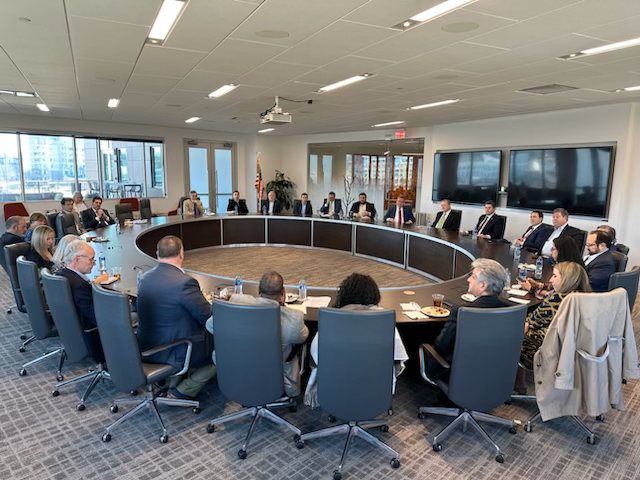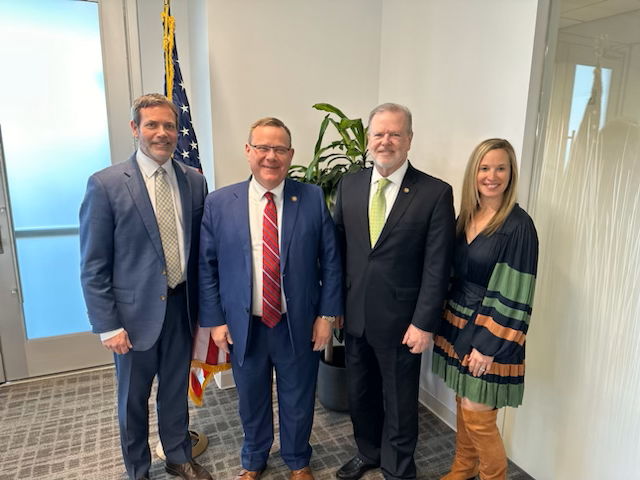

Regulatory reform was at the top of the agenda during yesterday‘s visit from North Carolina Senate President Pro Tem Phil Berger and House Speaker Tim Moore. Also in attendance were Senator Dave Craven and Senator Brad Overcash. We also welcomed House Senior Appropriations Chair Jason Saine who is responsible for developing and gaining approval of the State Budget. What were the highlights? The General Assembly members agreed to continue to strategically streamline and simplify the regulatory process aimed at making housing more attainable. They also mentioned their efforts to provide continued regulatory relief to, and the expansion of water and sewer capacity through additional funding to aid growing municipalities intelligently handle the influx of people choosing the Charlotte region as their new home.
Several industry leaders at the event brought up the subject of tax abatement strategies in other states, and how it is being successfully utilized to provide workforce and affordable housing, adding solid reasons why we need to explore its benefits more ardently here. Our guests expressed great interest in learning more about that solution and requested additional details. As such, we are enlisting assistance in putting together a presentation on how tax abatement works, specifically when scaled. We will note where it is being successfully utilized and include some examples of projects that have been built using this tool. The next step will be developing a detailed strategy that will include specific policy recommendations for future action at the General Assembly level.
Our Premier Members enjoyed and appreciated the direct access we received from these key members of the House and Senate who took their time to address matters of importance to the industry. We look forward to the next opportunity to check in with this group and we thank them for their continued support and leadership that has resulted, among other things, in North Carolina being the top place to do business in the country.
2. A Peek at Early Voting Data
We are more than halfway through in-person early voting and so far, more than 266,000 votes have been cast in North Carolina in the Democratic and Republican primaries. This week, we’re offering some toplines on the data and some high-level takeaways on turnout and money spent in competitive congressional primaries.
Some takeaways:
While early voting has traditionally seen higher turnout from Democrats than Republicans, 2024 is seeing a significant Republican turnout. More GOP ballots are being cast early this year than at this point in 2020 and 2022. 54% of all ballots cast so far are GOP ballots, and just 46% are Democratic. The cumulative GOP ballot vote is only 7.5% lower than the number of Democratic ballots cast in 2020, which reached more than 500k votes by the end of early voting.
30% more Republicans have turned out to early vote in 2024 than in 2020, and 21% more than 2022. On the Democratic side, turnout is up over 2022 by 2.5% and behind 2020 by 17%.
Two-thirds of Unaffiliated voters are choosing the GOP ballot and turning out in higher numbers than either primary in 2020 or 2022. Unaffiliated voters choosing the Democratic ballot have, for the most part, followed the same trend line as 2022.
The share of Black voters in the Democratic primary electorate is higher than this point in 2020, but behind 2022’s vote share. In 2020, Black voters made up a little more than a third of the Democratic primary vote. In 2022, Black voters made up 44% of the total votes cast during early voting. In 2024, Black voters are making up approximately 41% of the total vote so far. By raw votes, fewer Black voters have turned out in 2024 than in 2020 and 2022.
Competitive Congressional Primaries
Late last week, the pre-primary Federal Election Committee (FEC) reports came out giving us a final glimpse of how financially well-positioned the campaigns were heading into early voting. The report covers the beginning of the year through February 14.
There has been a significant amount of self-financing in contested congressional primaries. The highest campaign loan so far has been from Kelly Daughtry, running in CD-13, who loaned more than $2 million to her campaign, followed by fellow CD-13 challenger Fred Von Canon, who has loaned a total of $1.9 million. In CD-8, State Rep. John Bradford has loaned his campaign $1.25 million.
Daughtry also had the cash-on-hand advantage heading into early voting with nearly one million on hand, followed by Allan Baucom in CD-8 with 568k, Christian Castelli in CD-6 with nearly half a million, Bradford with $347k, and Laurie Buckhout in CD-1 with $315k.
In CD-1, Nash (Sandy Smith’s home county) and Wayne counties are making up 40% of the vote so far. A third of the vote in CD-6 is coming from Davidson County, where Trump-endorsed Addison McDowell was raised. In CD-8, 39% of the vote is coming from Union County. 30% of the vote in CD-10 is coming from Grey Mills’ home county of Iredell. Johnston County, home to Kelly Daughtry and DeVan Barbour in CD-13, is leading turnout with 32%.
As we head into the last week of early voting, we’ll be watching to see if the statewide GOP trend holds, or if South Carolina’s presidential primary outcome deters enthusiasm to pull a GOP ballot. We think it’s more likely that the competitive congressional primaries and legislative races across the state are doing more to drive turnout than the statewide races. On the Democratic side, we will continue to monitor the statewide trends and Black turnout, which could have an impact on the Democratic primaries for governor and attorney general, as well as some key NC House races.
My take: First I must say, that we encourage you to VOTE. Too many of us are giving away our power by NOT going to the polls. With that said, the early indications of a higher than average Republican voter turnout is likely due to a greater number of competitive Republican Primary Elections around the state. Voter intensity among all voters, regardless of party affiliation, is likely to pick up exponentially as we get closer to the General Election in November. North Carolina will be a significant battle ground in the Presidential race and we’ll also see a ton of activity associated with the contests for governor and attorney general. Strap in and hang on. It’s about to get nasty.
Rob Nanfelt
Executive Director, REBIC